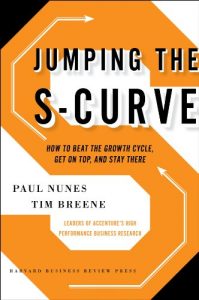How do an elite few companies, such as Samsung, P&G, Porsche, Danaher, Genentech, and Schlumberger achieve enduring and sustained out-performance of their peers? How do these companies grow revenue and increase profitability, not only in the short run, but even across economic and market disruptions?
In Jumping the S-Curve, Accenture authors Paul Nunes and Tim Breene share key insights from their multi-year study of high performance businesses. One of the largest and most comprehensive studies of business performance ever conducted, Nunes and Breene studied over 6000 companies from a multitude of industries around the world, and by applying a rigid set of criteria they found that less than one in twenty companies pass the test of sustained outperformance, and that what separates these high performers from their lesser-performing competitors is a focused agenda built on only three critical elements :
(1) A "Big Enough Market Insight" (BEMI) - Ability to identify big market opportunities in secular trends and prepare early to exploit them
(2) Competence Before Scaling - Ability to know precisely when to scale (lesser performers scale too quickly, higher performers wait...but not too long)
(3) Serious Talent - Ability to demand, and get, "stretch performances" from people at the top of the organization, as well as from those who are already great at what they do.
With detailed company examples, this book shows *how* companies manage these three pre-requisites to become high performers relative to their peers. But the authors go further, and explain how the elite few also sustain high performance over time, by becoming masters at balancing continuity with change. Outperformers know how to live with one foot in today and the other in tomorrow, and operationalize this by (1) encouraging regular churn at the top and continually swapping out key players, but with leaders who have long experience with the company; (2) embracing an ad hoc, instead of an institutional, strategy-making process; and (3) continually renewing talent and aligning their talent on what is needed to be successful in the future.
With detailed stories and insights from high performance businesses that have sustained outperformance across business cycles, Jumping the S-Curve provides a nuanced, and timeless, view into how to improve company performance.
In Jumping the S-Curve, Accenture authors Paul Nunes and Tim Breene share key insights from their multi-year study of high performance businesses. One of the largest and most comprehensive studies of business performance ever conducted, Nunes and Breene studied over 6000 companies from a multitude of industries around the world, and by applying a rigid set of criteria they found that less than one in twenty companies pass the test of sustained outperformance, and that what separates these high performers from their lesser-performing competitors is a focused agenda built on only three critical elements :
(1) A "Big Enough Market Insight" (BEMI) - Ability to identify big market opportunities in secular trends and prepare early to exploit them
(2) Competence Before Scaling - Ability to know precisely when to scale (lesser performers scale too quickly, higher performers wait...but not too long)
(3) Serious Talent - Ability to demand, and get, "stretch performances" from people at the top of the organization, as well as from those who are already great at what they do.
With detailed company examples, this book shows *how* companies manage these three pre-requisites to become high performers relative to their peers. But the authors go further, and explain how the elite few also sustain high performance over time, by becoming masters at balancing continuity with change. Outperformers know how to live with one foot in today and the other in tomorrow, and operationalize this by (1) encouraging regular churn at the top and continually swapping out key players, but with leaders who have long experience with the company; (2) embracing an ad hoc, instead of an institutional, strategy-making process; and (3) continually renewing talent and aligning their talent on what is needed to be successful in the future.
With detailed stories and insights from high performance businesses that have sustained outperformance across business cycles, Jumping the S-Curve provides a nuanced, and timeless, view into how to improve company performance.












